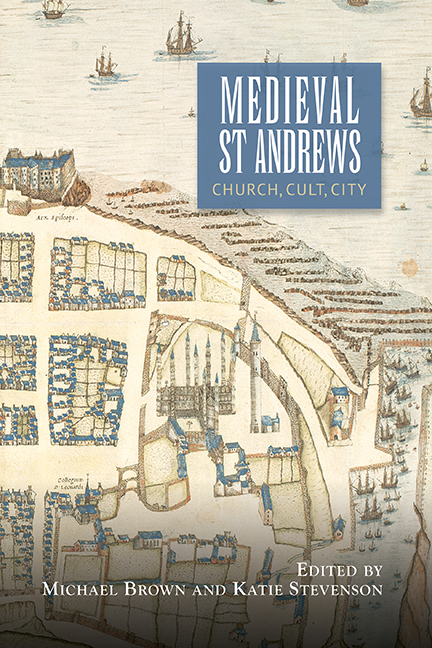Book contents
- Frontmatter
- Dedication
- Contents
- List of Illustrations, Charts and Tables
- Contributors
- Abbreviations
- 1 ‘Ancient Magnificence’: St Andrews in the Middle Ages: An Introduction
- 2 From Cinrigh Monai to Civitas Sancti Andree: A Star is Born
- 3 The Idea of St Andrews as the Second Rome Made Manifest
- 4 The Medieval Ecclesiastical Architecture of St Andrews as a Channel for the Introduction of New Ideas
- 5 When the Miracles Ceased: Shrine and Cult Management at St Andrews and Scottish Cathedrals in the Later Middle Ages
- 6 Religion, Ritual and the Rhythm of the Year in Later Medieval St Andrews
- 7 Living in the Late Medieval Town of St Andrews
- 8 The Burgh of St Andrews and its Inhabitants before the Wars of Independence
- 9 The Archaeology of Medieval St Andrews
- 10 Prelates, Citizens and Landed Folk: St Andrews as a Centre of Lordship in the Late Middle Ages
- 11 Augmenting Rentals: The Expansion of Church Property in St Andrews, c. 1400–1560
- 12 The Prehistory of the University of St Andrews
- 13 University, City and Society
- 14 The Medieval Maces of the University of St Andrews
- 15 Heresy, Inquisition and Late Medieval St Andrews
- Appendix 1 The St Andrews Foundation Account
- Appendix 2 The Augustinian' Account
- Appendix 3 The Boar' Raik
- Appendix 4 University of St Andrews Library, UYSL 110/6/4
- Index
- Miscellaneous Endmatter
11 - Augmenting Rentals: The Expansion of Church Property in St Andrews, c. 1400–1560
Published online by Cambridge University Press: 28 April 2017
- Frontmatter
- Dedication
- Contents
- List of Illustrations, Charts and Tables
- Contributors
- Abbreviations
- 1 ‘Ancient Magnificence’: St Andrews in the Middle Ages: An Introduction
- 2 From Cinrigh Monai to Civitas Sancti Andree: A Star is Born
- 3 The Idea of St Andrews as the Second Rome Made Manifest
- 4 The Medieval Ecclesiastical Architecture of St Andrews as a Channel for the Introduction of New Ideas
- 5 When the Miracles Ceased: Shrine and Cult Management at St Andrews and Scottish Cathedrals in the Later Middle Ages
- 6 Religion, Ritual and the Rhythm of the Year in Later Medieval St Andrews
- 7 Living in the Late Medieval Town of St Andrews
- 8 The Burgh of St Andrews and its Inhabitants before the Wars of Independence
- 9 The Archaeology of Medieval St Andrews
- 10 Prelates, Citizens and Landed Folk: St Andrews as a Centre of Lordship in the Late Middle Ages
- 11 Augmenting Rentals: The Expansion of Church Property in St Andrews, c. 1400–1560
- 12 The Prehistory of the University of St Andrews
- 13 University, City and Society
- 14 The Medieval Maces of the University of St Andrews
- 15 Heresy, Inquisition and Late Medieval St Andrews
- Appendix 1 The St Andrews Foundation Account
- Appendix 2 The Augustinian' Account
- Appendix 3 The Boar' Raik
- Appendix 4 University of St Andrews Library, UYSL 110/6/4
- Index
- Miscellaneous Endmatter
Summary
THE fifteenth and early sixteenth centuries saw a flowering in Scottish urban piety, with recent research highlighting the vitality of Catholic religious observance in late medieval Scottish towns and cities. During this period numerous new ecclesiastical foundations were established in burghs across the kingdom, whilst many existing churches were extended and developed. The expansion in religious provision was accompanied (and partly enabled) by a growth in the amount of church property within Scottish towns. Throughout the late Middle Ages large plots of urban land were converted to religious purposes, and extensive portfolios of secular properties, such as houses and crofts, were acquired by ecclesiastical institutions. This increase in urban church landholding was particularly apparent in St Andrews, where it transformed both the appearance and the economy of the city.
Religious institutions and officials had played a part in St Andrews landholding at least since the burgh's formal foundation in the twelfth century. Nevertheless, the late Middle Ages saw an increase both in the number of religious sites within the city and in the degree of financial burden ecclesiastical institutions placed on ordinary households. The layout of the urban settlement and the nature of the relationship between clergy and laity in St Andrews were redefined by the late mediaeval ecclesiastical expansion. This chapter aims to explore the extent of the fifteenth- and early sixteenth-century growth in church property within St Andrews and its implications for the local community.
At the start of the fifteenth century the main religious foundations in St Andrews were the cathedral, the collegiate church of St Mary on the Rock, the parish church of Holy Trinity, and the hospitals of St Leonard and St Nicholas. With the exception of the old leper hospital of St Nicholas (which stood a little distance from the burgh) all of these foundations were located in a distinct ecclesiastical zone at the eastern end of the city. To the west of the religious area lay the secular settlement of St Andrews, with its three main streets of South Gait, Market Gait and North Gait. The extent of the pre-fifteenth-century development along these thoroughfares is uncertain. By 1400 South Gait was divided up into burgage plots at least as far west as Logies Lane, and probably beyond.
- Type
- Chapter
- Information
- Medieval St AndrewsChurch, Cult, City, pp. 223 - 236Publisher: Boydell & BrewerPrint publication year: 2017



